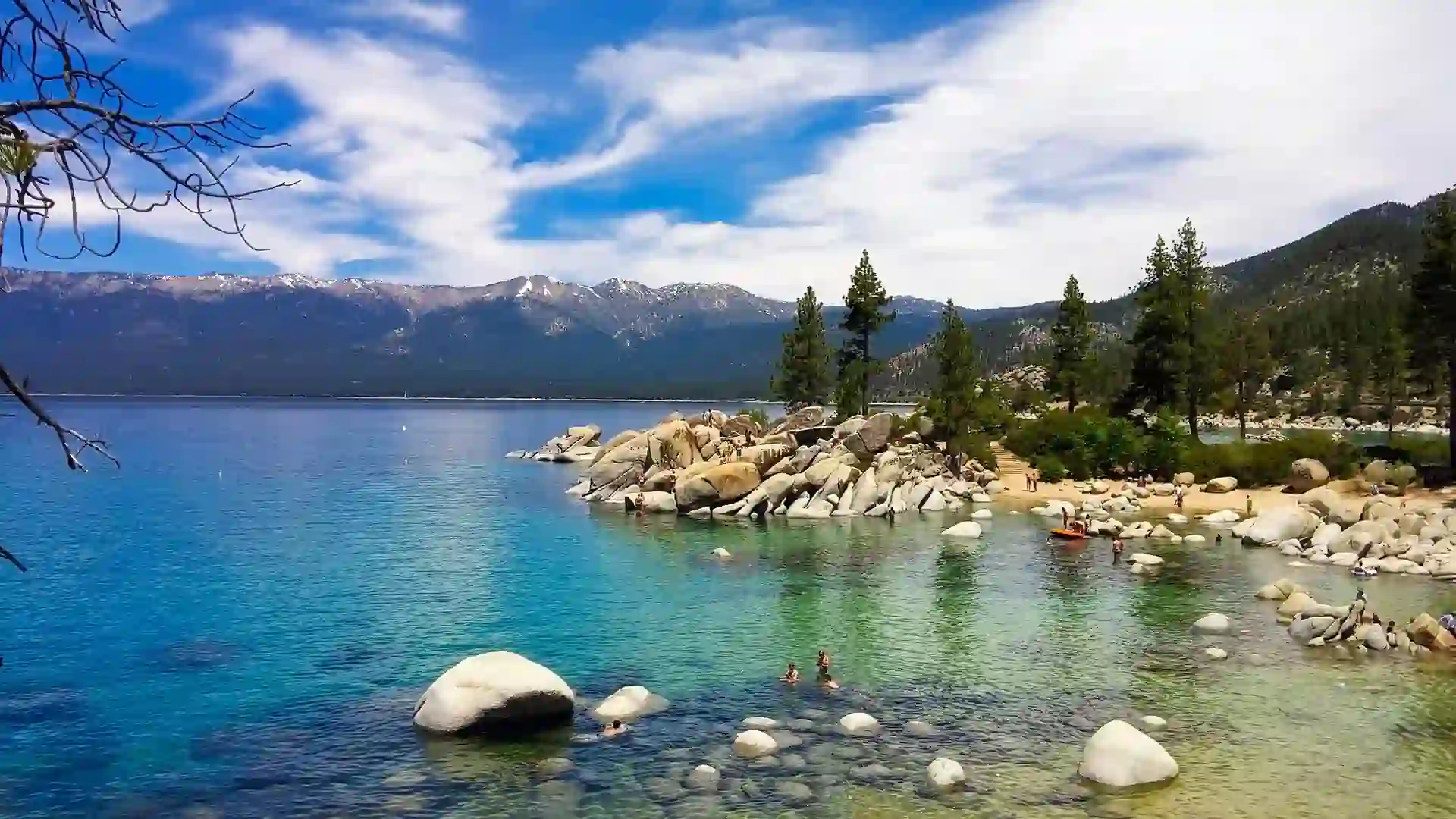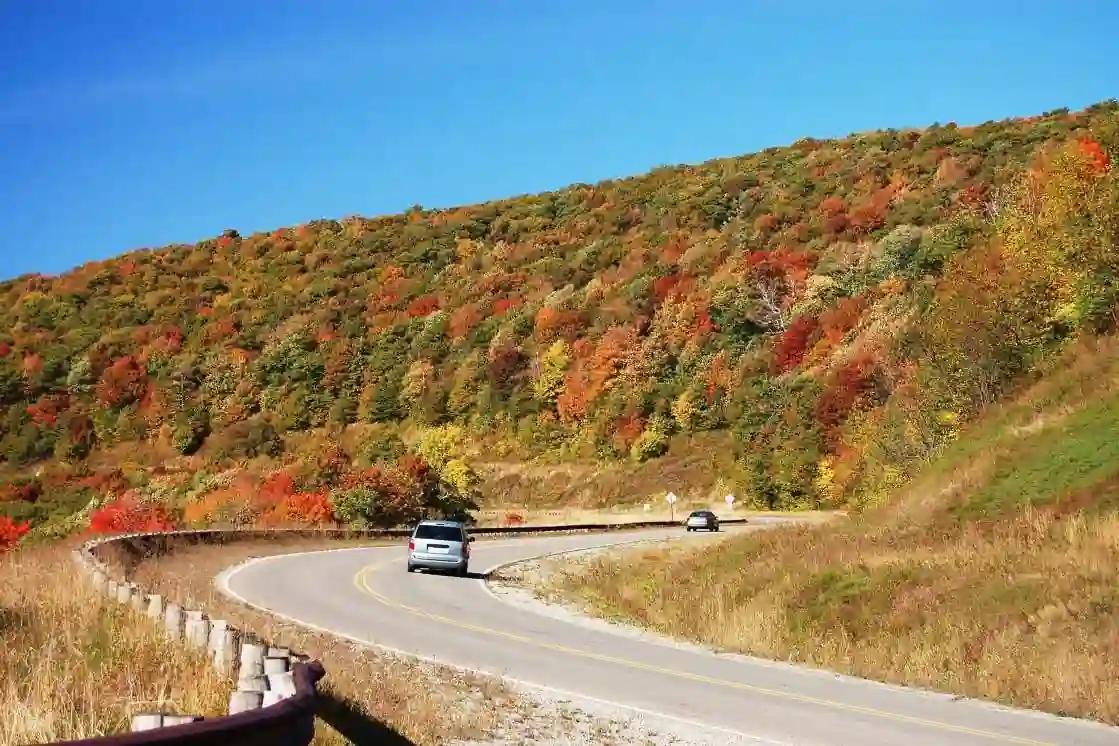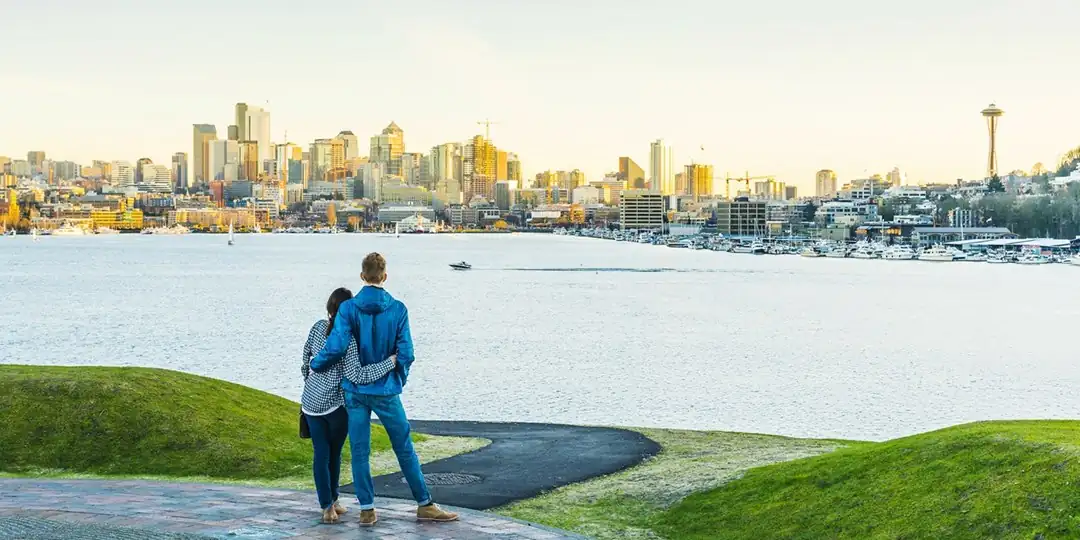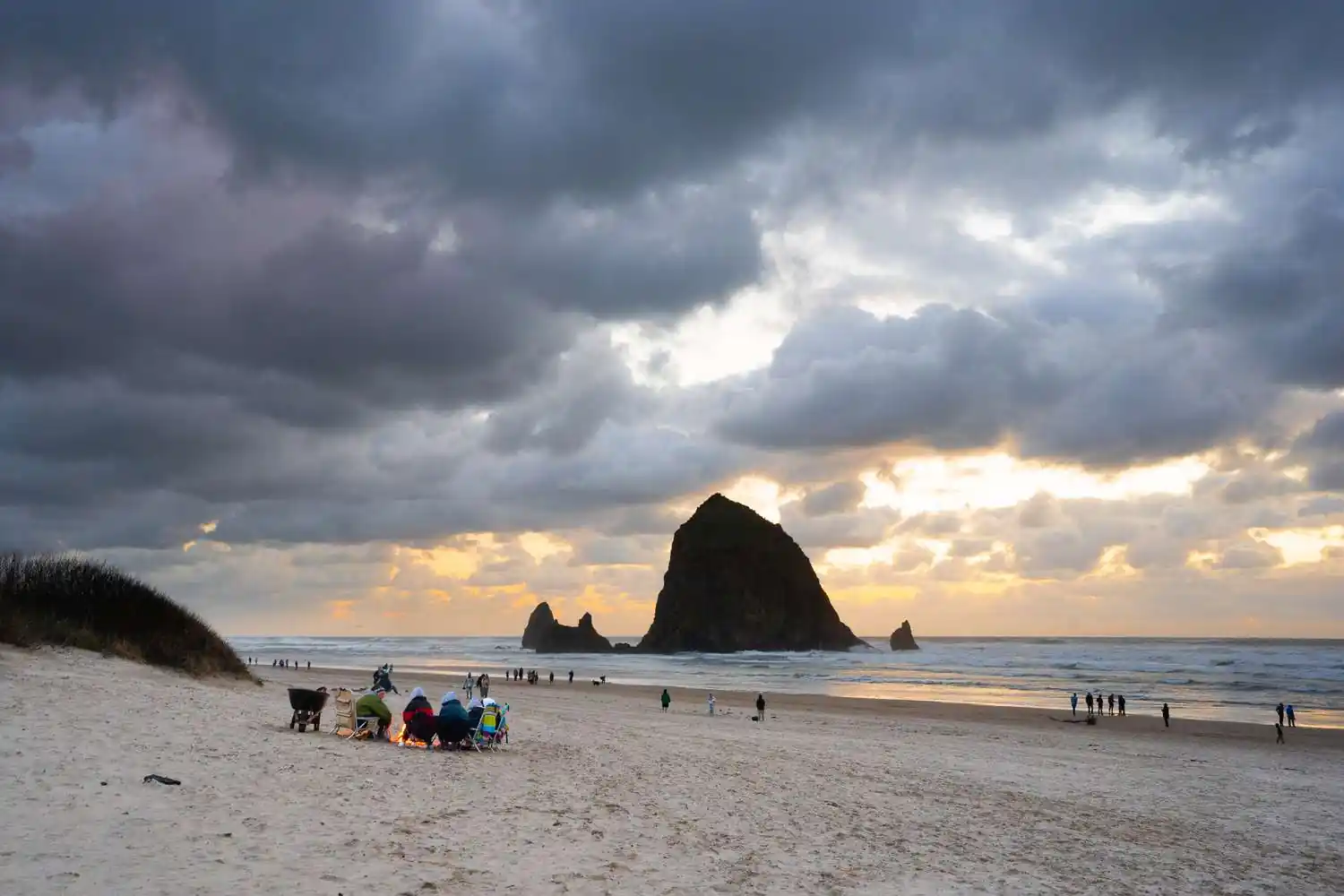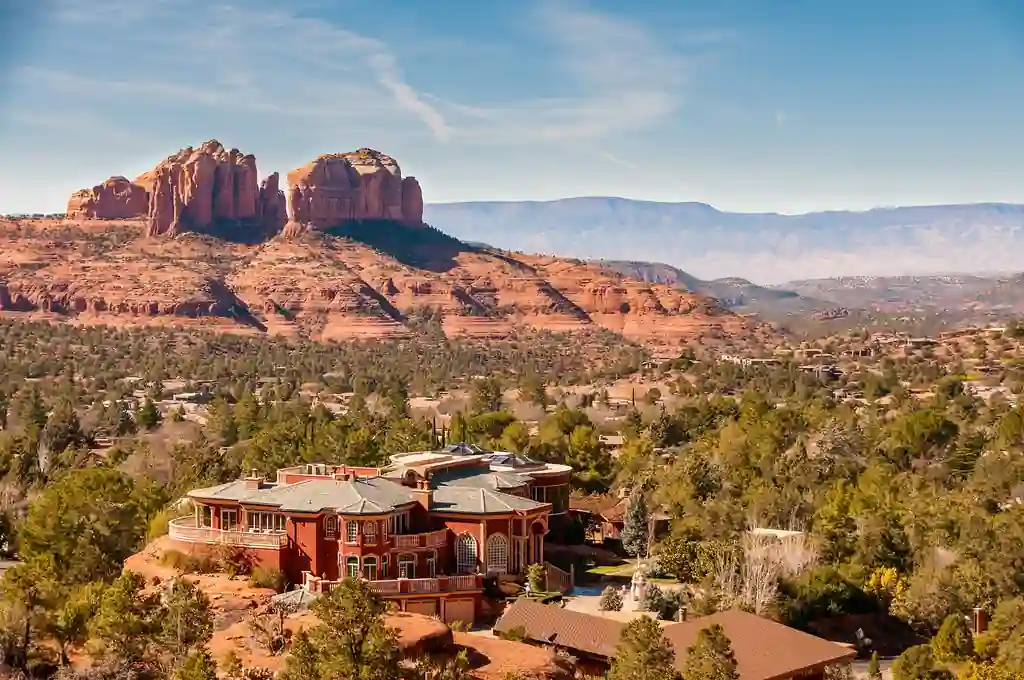It was just after sunrise when I stood on the rim of Crater Lake in Oregon, breath fogging in the thin morning air, my camera heavy in hand. The lake below looked impossibly blue—so blue it redefined the word for me. A mist lifted from the caldera, swirling like smoke, and for a brief moment, the silence felt ancient, like I was peering into a story older than time itself.
That morning wasn’t my first lake sunrise in the Western USA, nor my last. Over more than a decade of travel, I’ve kayaked through desert slot canyons at Lake Powell, ferried across the glacial waters of Lake Chelan, and camped beside the mirror-like surface of Jenny Lake in the Tetons.
I’ve spent summers driving along Montana’s Flathead Lake, autumns sipping wine with a view over Chelan’s hills, and even winter mornings when Tahoe’s glassy clarity felt almost surreal against the snowy peaks.
What I’ve learned is that these lakes are not just destinations—they’re living reflections of culture, geology, and memory. Each body of water carries stories: from Native traditions and ecological marvels to modern-day recreation and quiet solitude.
Some shimmer turquoise from glacial flour, others glow with volcanic depth, while a few—like Waldo Lake—are so pure they seem like distilled water poured into a vast bowl of forest.
Clearest Lakes in the Western USA
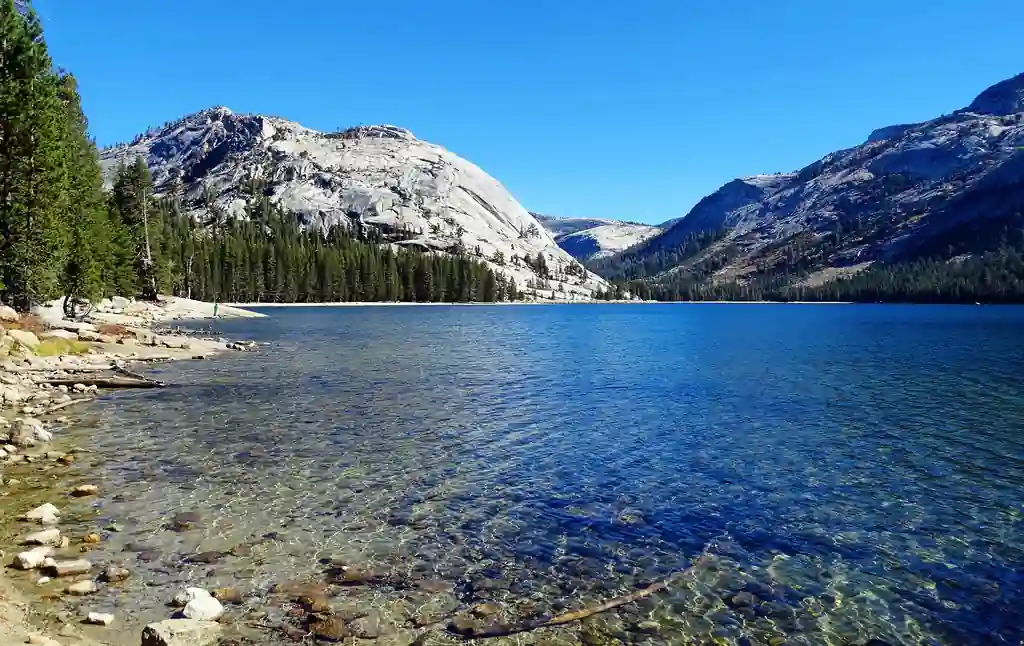
It’s an expert traveler’s journey through the clearest lakes in the Western USA, grounded in years of firsthand experiences, notes in my travel journals, and conversations with locals who know these waters best.
You’ll find insider tips on the best seasons to visit, practical advice for budgets and logistics, cultural insights you won’t find in guidebooks, and of course—those little travel lessons that come only from showing up, making mistakes, and returning again.
If you’re wondering where the clearest lakes in the U.S. are, or dreaming about lakes that rival the clarity of Caribbean waters, here’s your roadmap. From Oregon’s volcanic heart to Utah’s desert canyons, these 15 lakes will show you not just clarity of water, but clarity of experience.
1. Crater Lake, Oregon – A Blue That Redefines Blue
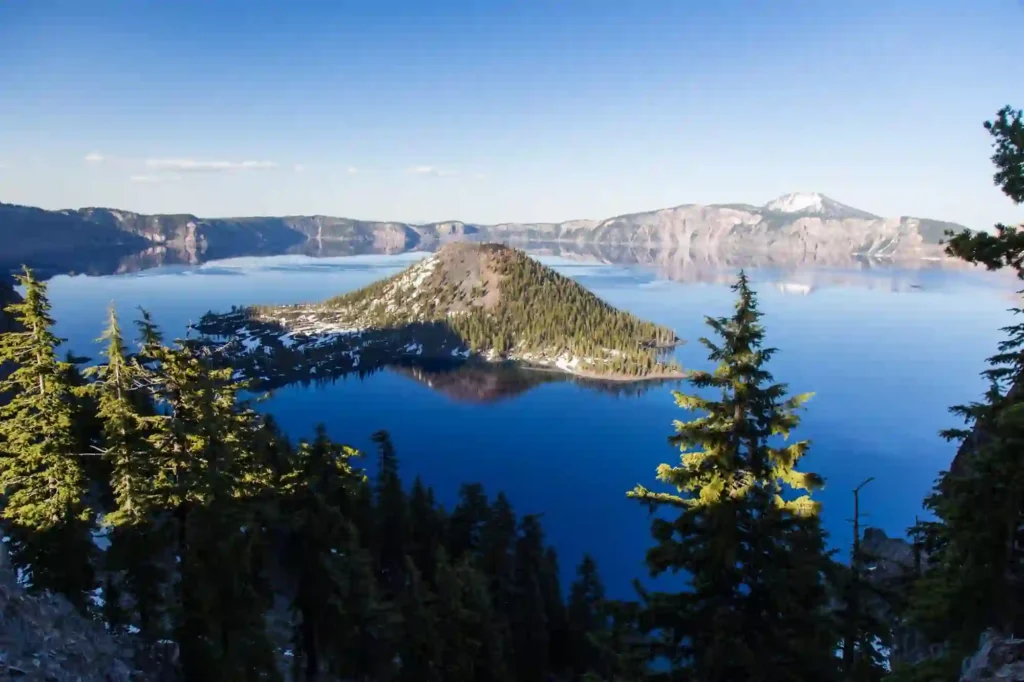
The first time I stood at the rim of Crater Lake National Park, I had to blink twice. The water below wasn’t just blue—it was the kind of blue that makes painters give up.
Formed nearly 7,700 years ago when Mount Mazama collapsed after a volcanic eruption, Crater Lake is the deepest lake in the United States (1,943 feet) and one of the clearest lakes in North America, with visibility often exceeding 100 feet.
My Travel Memory
It was July, just after dawn, and I’d driven the rim road before the tour buses arrived. Standing at Watchman Overlook, I watched sunlight spill over the caldera, catching the edges of Wizard Island and sending ripples of aquamarine across the surface.
I wasn’t alone—an older man from Klamath Falls leaned on the railing beside me and shared a story from his childhood: sneaking up here with his father before the park charged entrance fees. “It always feels like the world’s secrets live down there,” he said, nodding at the depths below.
That moment taught me something: Crater Lake isn’t just scenery—it’s cultural memory, scientific wonder, and pure magic rolled into one.
What Makes It Unique
- Clarity: Fed entirely by rain and snow, with no rivers flowing in or out, the lake naturally filters itself. This lack of sediment keeps the water almost impossibly pure.
- Color: The intense blue comes from the depth of the water absorbing every color except blue. On a sunny day, it’s like looking into liquid sapphire.
- Cultural Roots: For the Klamath people, this lake is sacred. Their oral traditions describe the battle between the sky god Skell and the god of the underworld, Llao, shaping the caldera itself.
Practical Travel Tips
- Best Viewpoints: Watchman Overlook (for sunset), Rim Village (for orientation), and Cloudcap Overlook (the highest accessible rim point).
- Boat Tours: In summer, you can take a boat to Wizard Island for hiking and fishing. Book ahead, as spots fill fast (~$55 per person).
- Best Time to Visit: Early July–September. Snow often blocks the rim drive until late June. If you come in September, the crowds thin and the clarity seems sharper in the cooler air.
- Budget Breakdown: $30 per car entry (valid 7 days), campsites from $21/night, Crater Lake Lodge from ~$250/night.
- Safety Note: Even in summer, nights can dip below freezing. The rim road is winding and can be icy until early July.
Insider Advice
- Bring a polarizing filter if you’re a photographer—it cuts glare and lets you capture the lake’s true hues.
- Sunrise is worth the early wake-up. Not only do you dodge crowds, but the water is calmest, creating the perfect mirror effect.
- If you’re short on time, prioritize the Rim Drive loop—33 miles of jaw-dropping views.
Why It Belongs on This List
Of all the clearest lakes in the United States, Crater Lake feels almost otherworldly. It’s not just a body of water—it’s a reminder of Earth’s power to destroy, heal, and inspire awe. Every time I visit, I leave with a clearer perspective, as if the lake’s transparency rubs off on me.
2. Lake Tahoe, California & Nevada – Clarity Meets Adventure
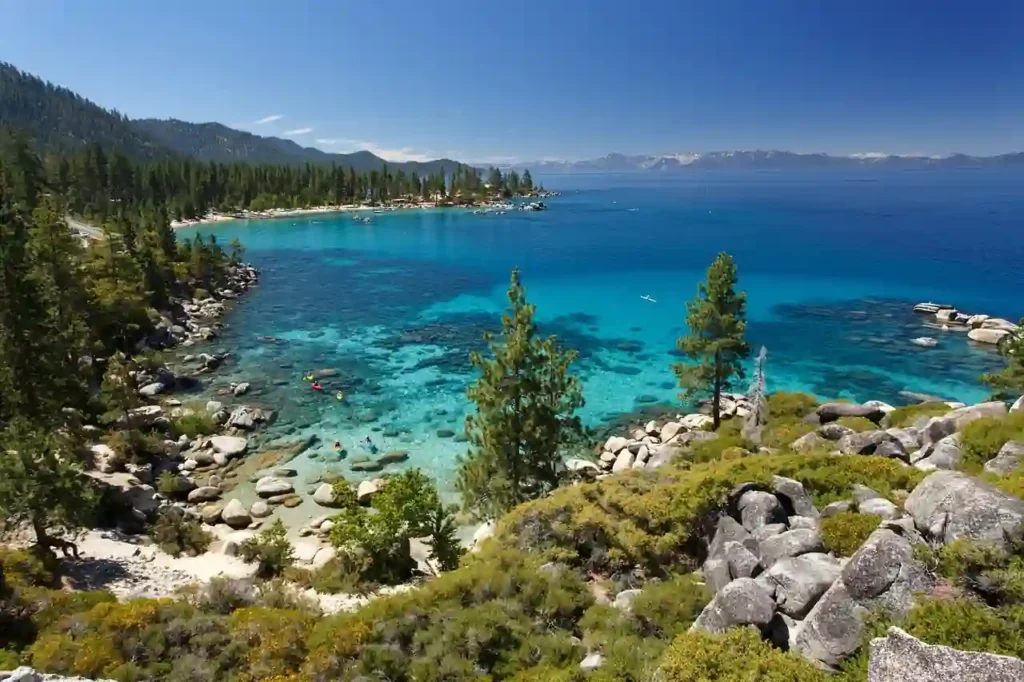
I’ll never forget the first time I dipped a paddle into Lake Tahoe’s glassy waters near Sand Harbor. Looking down from my kayak, I could see boulders resting 60 feet below, glowing in the sun like they were suspended in air. Tahoe’s water is so clear that at times it feels less like you’re floating and more like you’re flying.
Straddling the border of California and Nevada, Tahoe is not only one of the clearest lakes in the United States but also the largest alpine lake in North America.
Its clarity, though slightly diminished over the decades due to development and algae blooms, still makes it a world-class destination for travelers seeking both beauty and adventure.
Why Lake Tahoe Stands Out
- Clarity & Size: With visibility often reaching 70 feet, Tahoe offers one of the clearest freshwater lake experiences in the U.S.
- Adventure Hub: From skiing in winter to kayaking, hiking, and paddleboarding in summer, this lake is a year-round playground.
- Cultural Depth: Long before Tahoe was a tourist hotspot, the Washoe Tribe considered it sacred. Today, modern ski culture blends with this deep history.
- Accessibility: Unlike more remote lakes, Tahoe is easily reached via Reno-Tahoe International Airport, making it a favorite for both weekend getaways and extended vacations.
Top Spots for Crystal Views
| Spot | Why It’s Special |
| Sand Harbor (Nevada) | Shallow coves with rock formations beneath clear turquoise water—perfect for kayaks. |
| Emerald Bay (California) | A postcard-perfect view with Vikingsholm Castle and a forested backdrop. |
| Incline Village | Relaxed beaches with family-friendly swimming areas. |
| Eagle Lake Trail | Short hike with panoramic lake views and reflection shots. |
| Zephyr Cove | Great for boating and watersports rentals. |
When to Visit for Maximum Clarity
- Late Spring (May–June): Tahoe’s water clarity is at its peak, before algae blooms reduce visibility.
- September: Warm water, smaller crowds, and glassy morning reflections.
- Winter: Snow-capped mountains frame the sapphire lake—ideal for photographers.
Budget & Logistics
- Park Entry: Around $10 per vehicle at state parks.
- Kayak/Paddleboard Rentals: $40–50/day.
- Accommodation: Campgrounds from $30/night; lakeside resorts $200–500/night depending on season.
- Transport: Local shuttles connect beaches, trails, and ski areas; having a car offers the most freedom.
Cultural Insights
The Washoe people called the lake Da.aw, meaning “edge of the lake.” They viewed Tahoe as sacred, a place of balance and renewal. While modern visitors often come for the skiing, casinos, or nightlife, you’ll still find locals who emphasize the importance of preserving Tahoe’s fragile ecosystem.
Pro Tip for Travelers: 👉 Get on the water before 9 a.m. Winds pick up by late morning, stirring waves and reducing visibility. Early starts also mean you’ll share the lake with fewer crowds and catch reflections of the Sierra Nevada peaks in still, glass-like water.
Why Lake Tahoe Belongs on This List
Of all the US lakes with clear water, Tahoe offers the perfect combination of accessibility, natural beauty, and recreation. It’s both a pristine alpine lake and a bustling hub for year-round adventure.
Whether you’re chasing powder in January or paddling through emerald waters in June, Tahoe proves why it remains one of the clearest lakes in the Western USA—a place where clarity isn’t just in the water, but in the way it re-centers you.
3. Flathead Lake, Montana – The Jewel of Big Sky Country
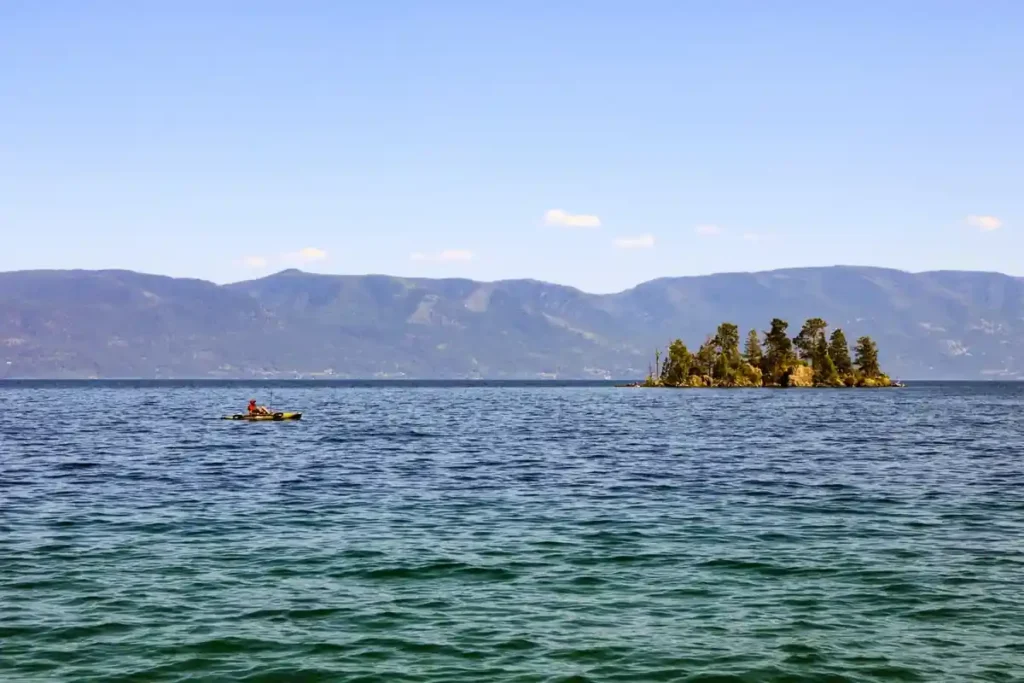
Driving along U.S. Highway 93 in western Montana, I remember pulling over more times than I can count just to stare at Flathead Lake. The road hugs its shoreline for miles, and on a clear summer day, the water glitters like a sheet of blue glass against the backdrop of the Mission Mountains.
At over 185 miles of shoreline, Flathead is the largest natural freshwater lake west of the Mississippi—and easily one of the clearest lakes in the western USA.
I first visited in late July during cherry season, when roadside stands overflowed with fresh Flathead cherries. After spending the morning hiking on Wild Horse Island—a funcity state park within the lake itself—I sat under a shade tree, sticky with cherry juice, and watched wild horses graze in the distance.
That mix of raw nature and small-town Montana charm is what makes Flathead feel so different from other alpine lakes I’ve explored across North America.
Why Flathead Lake is Special
- Size & Clarity: It’s massive (nearly 30 miles long), yet retains a transparency of 25–30 feet in many spots.
- Cultural Heritage: Long revered by the Salish and Kootenai Tribes, the lake continues to be central to their culture and stewardship.
- Diverse Activities: From boating and fishing to hiking and cherry orchard tours, it’s more than just a scenic stop—it’s a lifestyle hub for Western Montana.
- Wild Horse Island: Accessible only by boat, this park is home to wild horses, bighorn sheep, and bald eagles.
Traveler’s Guide at a Glance
| Aspect | Details |
| Best Season | July (cherry season) or September (fewer crowds, cooler air). |
| Top Activities | Boating, Wild Horse Island hiking, farmers’ markets, scenic drives. |
| Budget Tips | Campgrounds $20–30/night; boat rentals ~$150/day. |
| Access | Closest city: Kalispell (20 minutes). Glacier Park Int’l Airport nearby. |
| Safety Note | Afternoon thunderstorms form quickly—check weather before boating. |
Cultural Insight
Flathead isn’t just a playground—it’s sacred land. The Confederated Salish and Kootenai Tribes manage much of the southern shoreline. At summer markets, I’ve shared coffee with local elders who speak of the lake not as scenery but as a living relative.
Respect here means more than “leave no trace”—it means acknowledging a heritage that goes back thousands of years.
Pro Tip for Travelers: 👉 If you’re into aerial photography, check local drone regulations on tribal land before flying. A sunrise drone shot over Flathead, with the Mission Mountains mirrored in still waters, is unforgettable—but it must be done respectfully and legally.
Why Flathead Belongs on This List
Unlike many crystal-clear lakes in the Western U.S., Flathead balances wilderness and community. You can sip local wine in Polson, wander a farmers’ market in Bigfork, or paddle through turquoise water alongside osprey.
For me, it remains one of the best examples of how Western America’s clearest lakes offer not just beauty, but a deep sense of place.
4. Lake Chelan, Washington – Glacial Clarity with Wine Country Charm
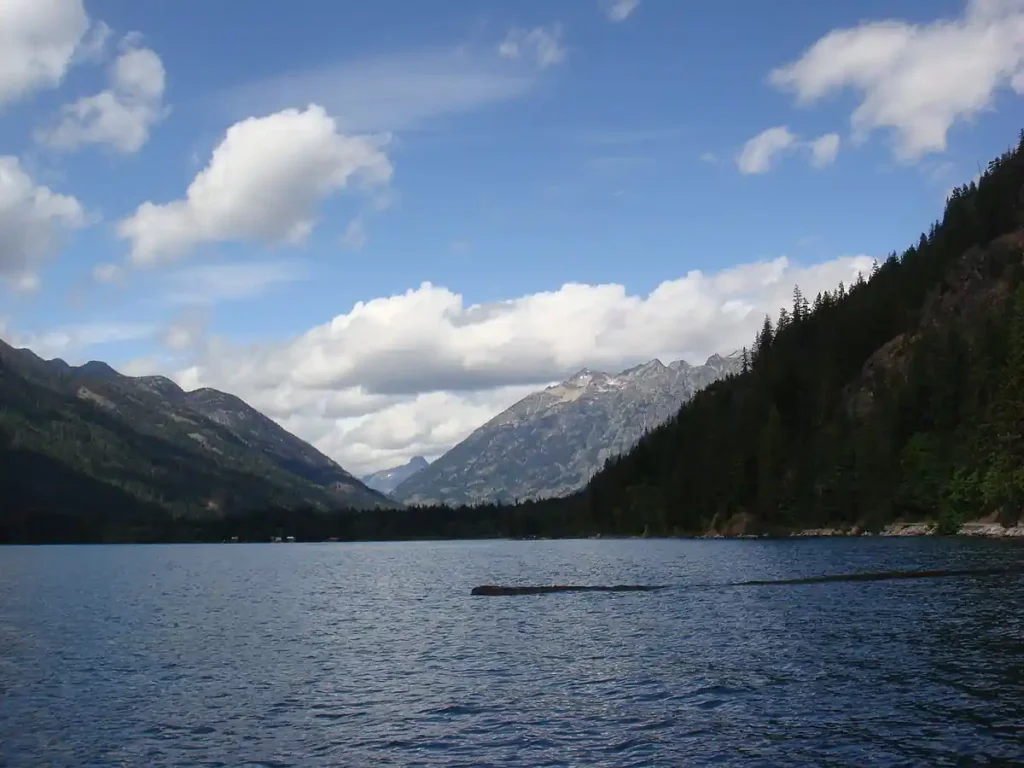
The first time I saw Lake Chelan, I was standing on a dock in the town of Chelan, early morning mist curling off the water like steam rising from a giant sapphire. The lake stretched endlessly into the North Cascades, narrowing as it disappeared into rugged wilderness.
At over 50 miles long and plunging more than 1,400 feet deep, Chelan is not just one of the clearest lakes in the Western USA—it’s one of the deepest in the country, second only to Oregon’s Crater Lake.
What sets Chelan apart is its rare combination of glacial purity and cultural vibrancy. On one end, the small town of Chelan hums with wine tasting rooms, farmer’s markets, and family-run orchards, while the other end, accessible only by boat or seaplane, leads into the wild, remote village of Stehekin.
Few lakes in North America balance accessibility, adventure, and cultural flavor quite like this.
Why Lake Chelan is Famous for Clarity
- Glacial Origins: Fed by glaciers in the North Cascades, its turquoise hue changes with the season and sunlight.
- Extreme Depth: At 1,486 feet, the depth filters out sediment and keeps the water pristine.
- Minimal Development: Strict regulations around the lake protect its clarity.
- Year-Round Destination: Swimming in summer, wine festivals in fall, snowshoeing nearby in winter.
Traveler’s Guide at a Glance
| Aspect | Details |
| Best Season | June–September (warm waters, wine harvest). |
| Top Activities | Wine tasting, boating, kayaking, Stehekin ferry trip, hiking into Cascades. |
| Budget Tips | Free public beaches in Chelan/Manson; off-season lodging deals in spring. |
| Access | Drive 3 hours from Seattle; regional shuttles available. |
| Unique Feature | Ferry ride to Stehekin—no roads lead there, only boats or seaplanes. |
What Makes Chelan Unique Among U.S. Lakes
Unlike Crater Lake or Tahoe, Chelan offers an immersive wine country experience right at the lakeshore. Over 30 boutique wineries surround the lake, many with patios overlooking the crystal water.
I once spent an afternoon kayaking in the sun, then swapped my paddle for a wine glass by sunset at a lakeside vineyard in Manson. Few places let you move so effortlessly from wilderness adventure to cultural indulgence.
Local Story Highlight
Talk to locals, and you’ll hear about Chelan’s “two worlds”: the social lakeside town buzzing with visitors, and the quiet remoteness of Stehekin, where mail still arrives by boat.
On one trip, I met a baker in Stehekin’s one and only bakery, who told me, “We measure time by ferries here, not by hours.” That sense of timelessness is why many travelers return.
Pro Tip for Travelers: 👉 Book the Lady of the Lake ferry early if you plan to visit Stehekin—it often sells out in summer. For the best clarity photos, aim for early morning or late afternoon when the sun softens the glare and the turquoise tones glow brightest.
Why Lake Chelan Deserves a Spot on This List
As one of the clearest lakes in the western USA and Washington, Chelan is a destination that feels both polished and untamed.
It’s where you can sip award-winning Syrah at noon, then camp under alpine stars by night. It’s more than a lake—it’s a glacial jewel framed by vineyards, wilderness, and community warmth.
5. Jenny Lake, Wyoming – Glacial Reflections in the Tetons
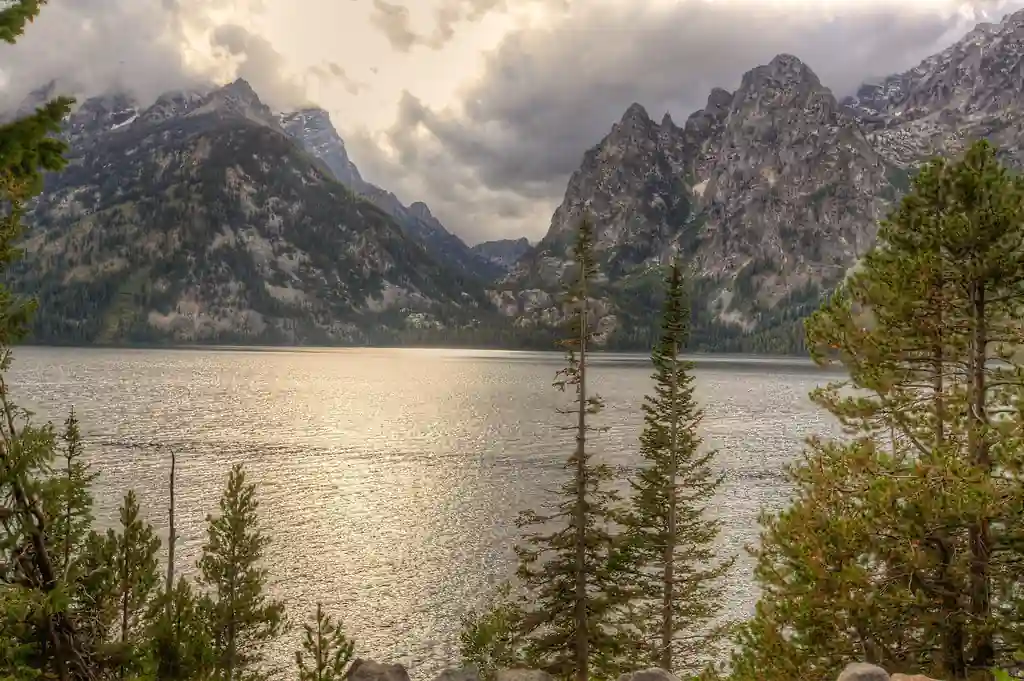
There are few places in the world where a lake feels like a living postcard, but Jenny Lake in Grand Teton National Park is one of them. Nestled at the base of the rugged Teton Range, this small but incredibly clear alpine lake is a showstopper.
I first visited on a crisp September morning, when the Cathedral Group peaks mirrored perfectly on the still surface—it was like nature had painted its own oil masterpiece.
Jenny Lake is one of the clearest lakes in the Western USA thanks to its glacial origins. Fed by runoff from the Tetons, its waters remain remarkably transparent, often allowing you to see rocks, fish, and submerged logs far below the surface.
Unlike deeper lakes such as Chelan or Crater, Jenny’s intimacy makes the clarity even more noticeable—you’re standing close to the mountains, close to the water, and close to the reflection of sky and stone.
Why Jenny Lake is Unforgettable
- Alpine Clarity: The glacial melt ensures ultra-pure, crisp water.
- Scenic Boat Ride: A shuttle boat runs across the lake, offering unbeatable mountain views.
- Gateway to Adventure: Trailheads to Hidden Falls and Inspiration Point start at the lake.
- Wildlife Sightings: Moose, black bears, and bald eagles often roam nearby.
- Protected Status: Located entirely within Grand Teton National Park, development is minimal.
Traveler’s Guide at a Glance
| Aspect | Details |
| Best Season | June–September (wildflowers, clear trails, open boat shuttles). |
| Top Activities | Hiking to Inspiration Point, scenic boat tours, wildlife photography. |
| Budget Tips | Use the free park shuttle for parking; pack snacks to avoid pricey lodges. |
| Access | 25 minutes from Jackson, WY. Park entrance fee applies. |
| Unique Feature | Sunrise reflections of the Tetons are considered some of the best in the U.S. |
Do’s & Don’ts at Jenny Lake
✅ Do take the boat shuttle early in the day to avoid crowds.
✅ Do bring bear spray on hikes—this is prime bear country.
❌ Don’t expect to swim long—the water is icy cold, even in July.
❌ Don’t skip sunrise—photographers consider it “golden hour magic.”
Cultural & Historical Insight
Jenny Lake was named after a Shoshone woman, the wife of Richard “Beaver Dick” Leigh, a 19th-century trapper and guide. While her story is often overshadowed by the grandeur of the mountains, acknowledging her name connects visitors to the Native presence that long predates the establishment of the park.
Pro Tip for Travelers: 👉 If you’re short on time, take the boat shuttle across Jenny Lake (10 minutes) and hike up to Hidden Falls and Inspiration Point—a quick but stunning half-day adventure that combines crystal-clear waters, waterfalls, and panoramic mountain views.
Why Jenny Lake Belongs on This List
Jenny Lake isn’t about size—it’s about intimacy with the Tetons. Its glass-like surface captures the soul of the mountains, offering one of the most photogenic and serene alpine lake experiences in all of Western America. If you want a lake that pairs crystal clarity with dramatic peaks, Jenny Lake is unmatched.
6. Waldo Lake, Oregon – Purest Water in the U.S.
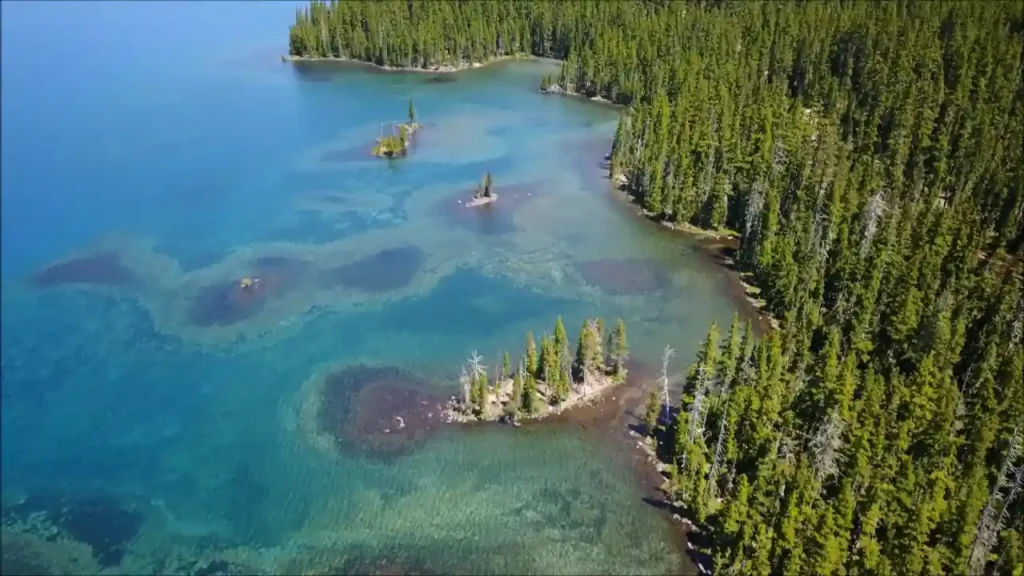
If there’s a lake that feels almost otherworldly, it’s Waldo Lake in Oregon. Tucked high in the Willamette National Forest, Waldo is often called one of the purest lakes in the United States—so clear that visibility can reach up to 120 feet below the surface. The first time I kayaked across it, I felt like I was floating on air. The water was so transparent that my paddle seemed to dip into liquid glass.
Unlike bigger names like Crater or Tahoe, Waldo is less visited, making it a hidden gem for those who crave solitude. There are no major towns on its shores, no flashy marinas, and no buzzing nightlife. Instead, you’ll find forest-lined campsites, quiet trails, and an almost spiritual silence broken only by the sound of loons or the ripple of your kayak.
Why Waldo Lake Stands Out
- Unmatched Purity: Nearly no nutrient input, meaning almost no algae growth.
- Eco-Friendly Reputation: Gas-powered motors are banned, protecting water quality.
- Backcountry Adventure: Surrounded by wilderness trails ideal for hikers and backpackers.
- Dark Sky Haven: With minimal development, Waldo is incredible for stargazing.
- Wild Yet Accessible: Just an hour’s drive from Eugene, Oregon.
Traveler’s Guide at a Glance
| Aspect | Details |
| Best Season | July–September (snow lingers late into spring at high elevation). |
| Top Activities | Kayaking, canoeing, paddleboarding, backcountry camping, stargazing. |
| Budget Tips | Free dispersed camping nearby; bring all supplies (no stores at the lake). |
| Access | About 90 minutes from Eugene, Oregon. Roads can be rough after snowmelt. |
| Unique Feature | Visibility down to 120 feet—like looking through liquid crystal. |
Eco-Friendly Travel Tips at Waldo Lake
✅ Bring a non-motorized boat (kayak, SUP, or canoe)—gas motors are banned.
✅ Pack it in, pack it out—there are no services.
✅ Filter or boil water—despite clarity, untreated water can still carry microbes.
❌ Don’t expect cell service—this is true wilderness.
Cultural & Natural Insight
Named after John B. Waldo, an Oregon conservationist, the lake has long symbolized the state’s environmental ethic. Local outdoor groups often describe it as a “sanctuary of silence.”
For the Klamath and Molalla Tribes, the forests and waters in this region are tied to ancestral lifeways, emphasizing respect for the lake’s fragility.
Pro Tip for Travelers: 👉 For the best clarity experience, kayak early in the morning when the water is mirror-still. If you’re camping, plan a new moon trip—the stars over Waldo are among the brightest skies in the Pacific Northwest.
Why Waldo Belongs on This List
Of all the crystal-clear lakes in the Western USA, Waldo Lake might be the most untouched and pristine. Its purity isn’t just about science—it’s about experience. Paddling here feels like time slows down, as if the lake itself is reminding you to breathe deeper and see clearer.
7. Lake Powell, Arizona/Utah – Desert Waters with Red Rock Drama
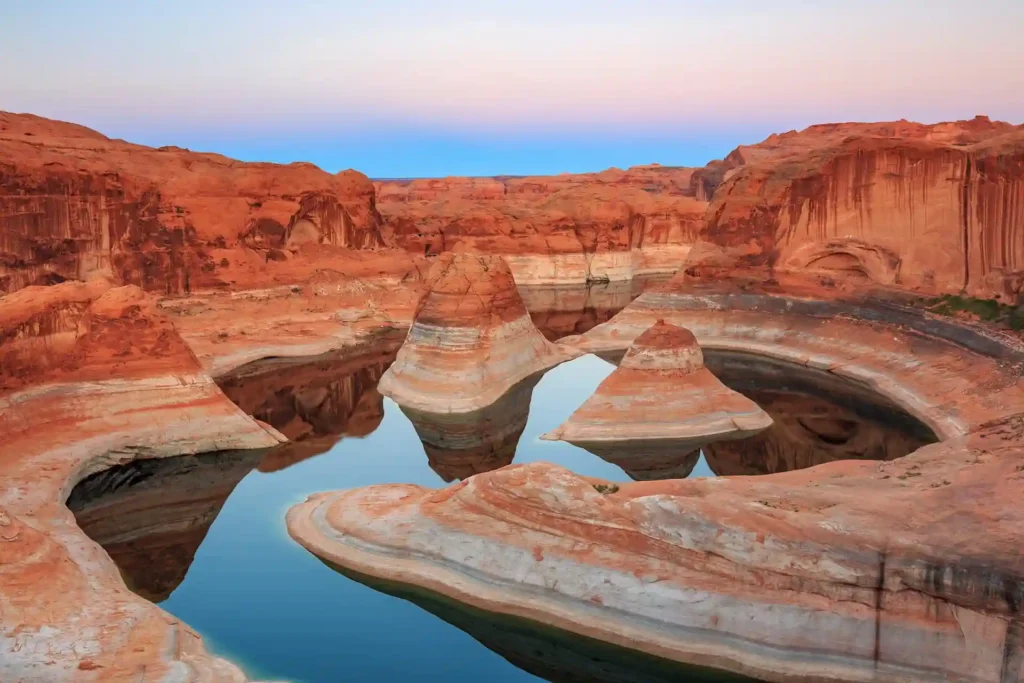
The first time I paddled through a narrow slot canyon on Lake Powell, the sandstone walls glowed orange while the water beneath shimmered a surreal shade of turquoise.
Unlike alpine lakes such as Tahoe or Waldo, this reservoir feels almost Martian—clear water pressed against towering red rocks, stretching over 1,900 miles of shoreline across Sedona Arizona, and Utah.
Lake Powell isn’t just one of the clearest lakes in the Western U.S.—it’s also one of the most adventurous. Created by the Glen Canyon Dam on the Colorado River, it blends human engineering with desert wilderness. Houseboats float like nomadic villages, kayakers slip into hidden canyons, and hikers discover ancient petroglyphs tucked into rock alcoves.
Why Lake Powell Stands Out
- Sheer Size: Second largest reservoir in the United States.
- Slot Canyon Exploration: Paddle into places boats can’t reach.
- Red Rock Drama: Clear waters framed by Navajo sandstone cliffs.
- Adventure Basecamp: Perfect for water skiing, fishing, or overnight houseboating.
- Cultural Respect: Much of the surrounding land belongs to the Navajo Nation, whose stewardship is essential to preserving this landscape.
Lake Powell Quick Travel Guide
| Aspect | Details |
| Best Season | Spring (April–May) & Fall (Sept–Oct). Summers can hit 110°F. |
| Top Access Points | Page (AZ), Wahweap Marina, Bullfrog Marina (UT). |
| Popular Activities | Kayaking slot canyons, houseboating, fishing, Rainbow Bridge boat trip. |
| Budget Breakdown | Entry $30/car (7 days), kayak rentals ~$45/day, houseboats ~$800+/night. |
| Photography Highlights | Antelope Canyon, Reflection Canyon, sunrise at Lone Rock Beach. |
Adventure Activities at Lake Powell
- 🚤 Houseboating: A floating home for exploring hidden coves.
- 🛶 Kayaking: Quiet paddling into narrow canyons where larger boats can’t go.
- 🎣 Fishing: Known for bass and striped bass.
- 🥾 Hiking: Don’t miss trails near Rainbow Bridge National Monument.
- 🌌 Stargazing: With vast desert skies, Lake Powell is a dark sky wonderland.
Safety & Sustainability Tips
✅ Watch for storms: Desert weather changes quickly; flash floods are real.
✅ Hydrate constantly: Even on the water, the desert sun is unforgiving.
✅ Respect Navajo Nation lands: Permits may be required for hiking beyond designated areas.
✅ Leave no trace: With drought conditions, preserving water quality is critical.
Pro Tip for Travelers: 👉 If you’re short on time, rent a kayak from Antelope Point Marina and paddle into Antelope Canyon. It’s less crowded than the hiking portion and lets you experience the fusion of red rock slot canyons with crystal-clear desert water—a scene you won’t find anywhere else in the United States.
Why Lake Powell Belongs on This List
While not a natural alpine lake like Crater or Jenny, Lake Powell is one of the clearest U.S. lakes in a desert setting. It offers a rare combination: clarity, adventure, and cultural depth. Here, the contrast of blue water against fiery sandstone is a reminder of how diverse the clearest lakes in North America can be.
8. Diablo Lake, Washington – Glacier-fed Emerald Waters
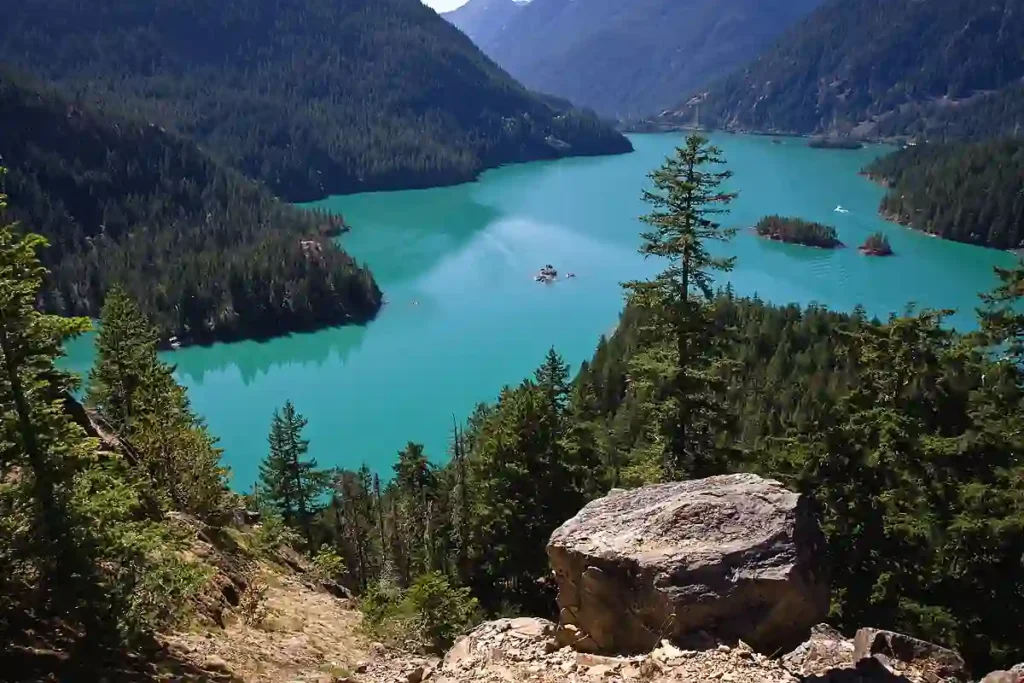
The first time I rounded the bend on the North Cascades Highway (Highway 20) and saw Diablo Lake stretched out below me, I had to pull over. The water looked unreal—an emerald so vibrant it seemed painted onto the valley. But this isn’t Photoshop.
The unique hue comes from glacial flour, tiny rock particles carried down by surrounding glaciers that scatter sunlight and turn the water a brilliant turquoise-green.
Unlike Lake Tahoe or Crater Lake, where clarity is about depth and transparency, Diablo Lake’s magic lies in its color and alpine setting. Nestled in North Cascades National Park, it offers one of the most photogenic and accessible stops on a road trip through Washington State.
Why Diablo Lake Stands Out
- Emerald Color: Caused by glacial sediment reflecting light.
- Accessible Beauty: You don’t need to hike miles—just pull over at Diablo Lake Overlook.
- Adventure Ready: Kayaking, canoeing, and fishing in a pristine alpine setting.
- Gateway to Wilderness: Surrounded by rugged peaks and alpine trails.
- Perfect Road Trip Stop: Right along the scenic Highway 20 corridor.
Traveler’s Guide at a Glance
| Aspect | Details |
| Best Season | July–September (when the highway is fully open; snow lingers until late June). |
| Top Access Point | Diablo Lake Overlook on Hwy 20 (free, no pass required). |
| Popular Activities | Kayaking, paddleboarding, fishing, hiking the Thunder Knob Trail. |
| Budget Breakdown | Free access; kayak rentals ~$35/day in nearby towns like Marblemount. |
| Photography Highlights | Overlook at sunrise, canoe on emerald water, dramatic peaks behind lake. |
Things to Do at Diablo Lake
- 🚣 Paddle the Waters – Bring or rent a kayak to glide across the emerald surface.
- 🥾 Hike Thunder Knob Trail – 3.6-mile moderate hike with panoramic views of the lake.
- 📸 Visit Diablo Lake Overlook – The most iconic (and easiest) view in North Cascades.
- 🐟 Fishing – Rainbow trout and other species thrive here.
- 🚗 Scenic Drive – Continue along Highway 20 for endless alpine vistas.
Eco & Safety Tips
✅ Pack layers—the Cascades weather shifts quickly.
✅ Respect the wilderness—this is part of a national park, so leave no trace.
✅ Summer is busy—arrive early in the day for parking and quiet.
❌ Avoid swimming in early summer—the glacial runoff keeps the water frigid.
Pro Tip for Travelers: 👉 Visit Diablo Lake in late afternoon golden hour. The emerald water glows even brighter as sunlight angles across the valley. Pair it with a picnic at the overlook, and you’ll understand why Diablo ranks among the most stunning clear lakes in the United States.
Why Diablo Belongs on This List
Diablo Lake may not be the deepest or largest, but its emerald clarity and glacier-fed purity make it unforgettable. For anyone road-tripping the Pacific Northwest or exploring the clearest lakes in North America, it’s a must-stop. Few places combine accessibility, dramatic color, and wilderness in one package quite like this.
9. Maroon Lake, Colorado – Mirror of the Maroon Bells
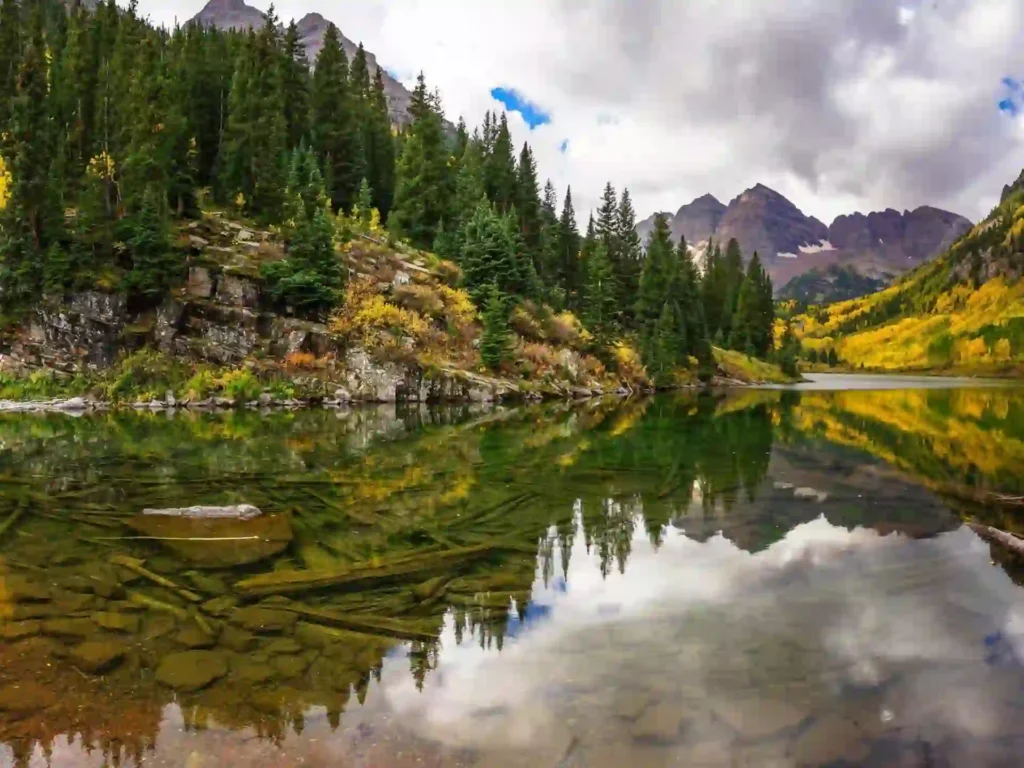
Few lakes capture the spirit of the Rocky Mountains quite like Maroon Lake, just outside Aspen, Colorado. Sitting at the base of the Maroon Bells, two iconic 14,000-foot peaks, this alpine lake is famed for its crystal clarity and picture-perfect reflections. In fact, it’s one of the most photographed and clearest lakes in the western USA.
The first time I arrived at sunrise, I joined a quiet crowd of photographers, tripods set along the shoreline. As the sun crested, the Maroon Bells glowed pink and gold, their reflection mirrored perfectly on the lake’s surface.
It was so still that the scene looked more like a painting than real life. This is where you realize why Maroon Lake is often considered one of the clearest alpine lakes in North America.
Why Maroon Lake Stands Out
- Iconic Reflections: Clear water perfectly mirrors the Maroon Bells.
- Photographer’s Paradise: Best visited at dawn for calm waters and glowing peaks.
- Seasonal Beauty: Wildflowers in July, golden aspens in late September.
- Accessible Wilderness: Easy access from Aspen, yet surrounded by rugged wilderness.
- Part of a Protected Area: Located in the Maroon Bells–Snowmass Wilderness.
Traveler’s Guide at a Glance
| Aspect | Details |
| Best Season | Late June–October (accessible after snow melts). |
| Top Activities | Photography, short hikes, picnicking, fall foliage viewing. |
| Budget Breakdown | $10 vehicle entry (reservation required), shuttle from Aspen ~$16 roundtrip. |
| Nearby Trails | Maroon Lake Scenic Trail, Crater Lake Trail, Maroon-Snowmass backpacking loop. |
| Photography Highlights | Sunrise reflections, wildflowers in summer, golden aspens in fall. |
Things to Do at Maroon Lake
- 🌅 Sunrise Photography – Arrive before dawn to catch the alpenglow on the Bells.
- 🥾 Hike the Scenic Trail – A flat, family-friendly walk around the lake’s shoreline.
- 🌼 Wildflower Viewing – Mid-July brings alpine meadows in full bloom.
- 🍂 Fall Foliage – Late September turns the aspen groves into a sea of gold.
- 🎒 Backpacking Gateway – Start the 26-mile Four Pass Loop, one of Colorado’s most famous treks.
Eco & Safety Tips
✅ Reserve in advance – Vehicle access is limited; most visitors must take a shuttle.
✅ Pack layers – Even in summer, mornings can be near freezing.
✅ Arrive early – Parking fills quickly, and sunrise is the prime moment.
❌ Don’t wade into the lake – It damages fragile ecosystems and ruins reflection shots for others.
Pro Tip for Travelers: 👉 Visit in late September. The combination of clear alpine water, golden aspens, and snow-dusted peaks makes Maroon Lake one of the most stunning fall photography destinations in the entire United States.
Why Maroon Lake Belongs on This List
When it comes to crystal clear lakes in North America, Maroon Lake blends pristine alpine clarity with unbeatable mountain backdrops. It’s not just a lake—it’s a reflection of Colorado’s wild beauty, where nature’s palette shifts with each season.
10. Payette Lake, Idaho – Mountain Serenity in McCall
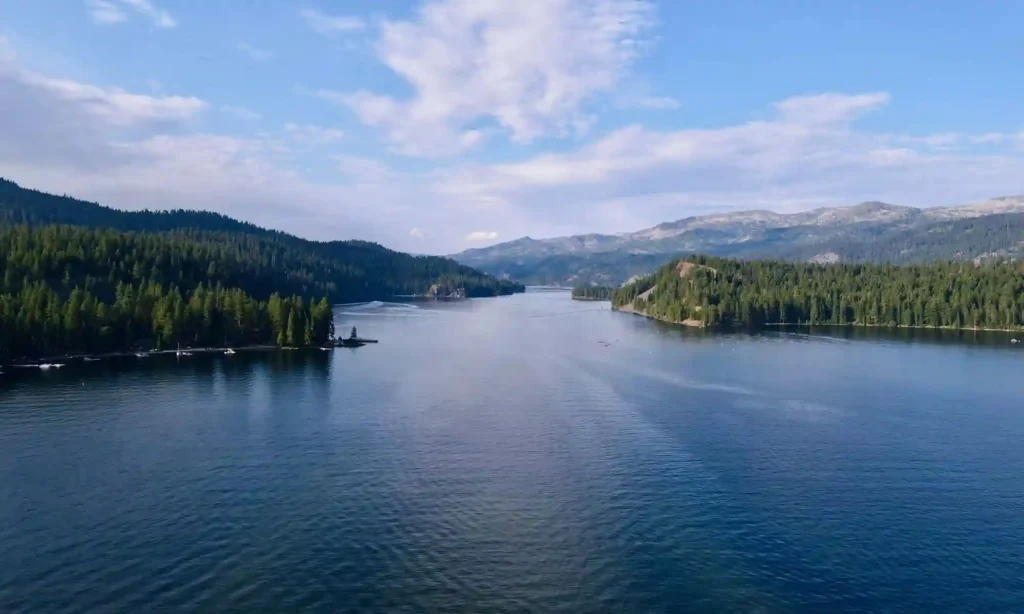
Nestled beside the charming town of McCall, Idaho, Payette Lake is a shimmering alpine gem known for its clear blue waters and mountain setting. Surrounded by dense pine forests and granite peaks, this crystal clear mountain lake in the Western USA is as much about recreation as it is about serenity.
The first time I kayaked across Payette Lake, the water was so transparent near the shoreline that I could see smooth stones and darting fish beneath my paddle. Unlike some of the remote alpine lakes, Payette balances wilderness with accessibility—making it a perfect family-friendly clear lake destination in the United States.
Why Payette Lake Stands Out
- 🌊 Crystal Clear Waters – Ideal for boating, kayaking, and paddleboarding.
- 🏔️ Scenic Mountain Setting – Framed by the Payette National Forest.
- 🛶 Recreation-Friendly – From summer watersports to winter ice skating.
- 🌲 Year-Round Destination – Summer lakeside fun, fall foliage, and nearby skiing in winter.
- 🏡 Small-Town Charm – McCall offers cozy lodges, cafes, and a relaxed mountain vibe.
Traveler’s Guide at a Glance
| Aspect | Details |
| Best Season | June–September for lake activities, December–March for snow sports. |
| Top Activities | Kayaking, paddleboarding, sailing, swimming, winter skating. |
| Budget Breakdown | Free shoreline access, kayak rentals ~$20/hour, boat tours ~$40–60. |
| Nearby Attractions | Burgdorf Hot Springs, Ponderosa State Park, Brundage Mountain Resort. |
| Family-Friendly Perks | Sandy beaches, safe swimming areas, lake cruises, easy hikes. |
Things to Do at Payette Lake
- 🛶 Paddleboarding & Kayaking – Calm waters near the shoreline are beginner-friendly.
- 🚤 Lake Cruises – Scenic boat tours showcase wildlife and mountain views.
- 🌲 Hiking at Ponderosa State Park – Explore trails with lake vistas and wildflowers.
- 🏖️ Beach Time – North Beach offers sandy spots for families and picnics.
- 🏔️ Winter Adventures – Ice skate on the lake or ski at nearby Brundage Mountain.
- 🔥 Soak in Hot Springs – Burgdorf and Gold Fork Hot Springs are within driving distance.
Eco & Safety Tips
✅ Water Safety First – Weather changes quickly in the mountains; bring life jackets.
✅ Support Local Rentals – Kayaks, paddleboards, and boats are easily available in McCall.
✅ Respect Wildlife – Ospreys, eagles, and deer are common around the lake.
❌ Avoid Overcrowding – Weekends in July can be packed; weekdays are quieter.
Pro Tip for Travelers: 👉 Visit in late August when the summer crowds thin out but the lake is still warm. This is the sweet spot for crystal clear water views, peaceful paddling, and small-town Idaho charm.
Why Payette Lake Belongs on This List?
With its mix of mountain serenity, family-friendly recreation, and crystal-clear waters, Payette Lake is more than just a beautiful stop—it’s a full experience.
For travelers seeking both outdoor adventure and relaxation in one of the clearest lakes in the Western USA, McCall delivers in every season.
11. Lake Crescent, Washington – Glacier-Carved Jewel of Olympic National Park
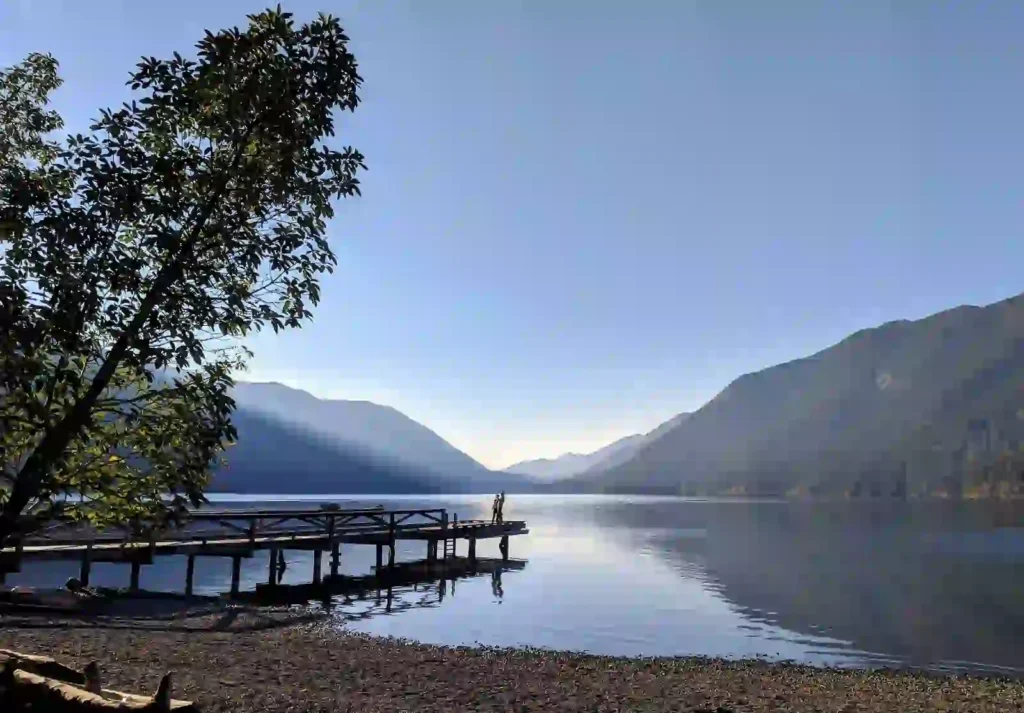
Tucked within the Olympic National Park on Washington’s rugged Olympic Peninsula, Lake Crescent is one of the clearest glacier-carved lakes in the United States. Its extraordinary transparency comes from a unique geological history: carved by massive glaciers, the lake has extremely low nitrogen levels, which limit algae growth and keep the water dazzlingly clear.
Standing on its shoreline, you’ll see water so transparent that submerged tree trunks look as if they’re floating in air. In deeper sections, the water shifts to a mesmerizing shade of sapphire, often compared to Lake Tahoe—but with a quieter, wilder ambiance. It’s not just a lake; it’s a window into the natural history of the Pacific Northwest.
Why Lake Crescent Stands Out
- 🌊 Exceptional Clarity: Glacial origins + low nitrogen = almost no algae.
- 🏔️ Olympic Wilderness: Encircled by peaks and temperate rainforest.
- 🛶 Adventure-Friendly: Great for kayaking, paddleboarding, and canoeing.
- 🌲 Secluded Serenity: Less crowded than other national park hotspots.
- 🏡 Historic Lodges: Lake Crescent Lodge offers rustic, lakeside stays.
Traveler’s Guide at a Glance
| Aspect | Details |
| Best Season | May–September for lake access; fall for quieter visits. |
| Top Activities | Kayaking, hiking, fishing, photography, swimming (cold water!). |
| Budget Breakdown | Free with national park entry; kayak rentals ~$25–40/day. |
| Nearby Attractions | Marymere Falls, Sol Duc Hot Springs, Hurricane Ridge, Lake Crescent Lodge. |
| Unique Fact | Depth reaches 624 feet, making it one of the deepest lakes in Washington. |
Things to Do at Lake Crescent
- 🛶 Kayak or Canoe – Paddle across glass-like waters surrounded by forested slopes.
- 🌲 Hike to Marymere Falls – A short trail leads to a 90-foot waterfall.
- 📸 Photography Stop – Sunrise creates golden reflections on still water.
- 🎣 Fishing – Try catching the rare Beardslee and Crescenti trout, found only here.
- 🏡 Stay at a Historic Lodge – Cozy cabins along the shore offer old-world charm.
Eco & Safety Tips
✅ Water is Cold – Even in summer, hypothermia is a risk. Limit swimming to shallow areas.
✅ Respect the Ecosystem – Lake Crescent’s clarity relies on its fragile balance. Avoid polluting.
✅ Wildlife Awareness – Black bears and deer are common in the surrounding forests.
❌ No Motor Overuse – Gas-powered boats are restricted in many parts of the lake to preserve its serenity.
Pro Tip for Travelers: 👉 For the most unforgettable experience, rent a kayak and paddle at sunset, when the Olympic Mountains glow and the lake reflects the sky in surreal shades of gold and blue. Few spots in the Western USA rival this kind of natural spectacle.
Why Lake Crescent Belongs on This List?
If you’re searching for the clearest lakes in the Western USA, Lake Crescent is a must-visit. Its mix of scientific uniqueness, glacier-carved clarity, and pristine wilderness access makes it both a natural wonder and a perfect traveler’s escape in the heart of Olympic National Park.
🧳 How to Plan a Clear Lake Road Trip in the Western U.S.
If you’re ready to see these wonders for yourself, here’s a road-trip style travel strategy that connects several lakes in one unforgettable journey:
- Start in Oregon – Visit Crater Lake and Waldo Lake for unmatched clarity.
- Head North to Washington – Explore Lake Chelan, Lake Crescent, and Diablo Lake.
- Cross into Idaho & Montana – Discover Flathead Lake, Stanley Lake, and Payette Lake.
- Swing South to Wyoming & Utah – Experience Jenny Lake and Bear Lake.
- Finish in California & Nevada – See the surreal Mono Lake, the legendary Lake Tahoe, and tribal lands at Pyramid Lake.
🗓️ Best Time to Visit the Clearest Lakes in the Western USA
| Season | Why It’s Great |
| Spring (Apr–May) | Snowmelt feeds alpine lakes, trails reopen, fewer crowds. |
| Summer (Jun–Aug) | Best for swimming, boating, and family lake trips (but also peak tourist season). |
| Fall (Sep–Oct) | Crystal waters remain clear, vineyards harvest in Chelan, fewer crowds. |
| Winter (Nov–Mar) | Skiing near Tahoe, snowshoeing near Stanley Lake, lakes less accessible. |
🌍 Sustainable Travel Tips for Visiting Clear Lakes
✅ Leave No Trace – Pack out trash, avoid sunscreen that harms freshwater ecosystems.
✅ Respect Indigenous Lands – Many lakes (like Pyramid Lake and Lake Powell) are sacred; follow local rules.
✅ Use Human-Powered Boats – Paddleboards and kayaks protect clarity better than gas-powered engines.
✅ Travel Off-Season – Reduce crowding and help preserve fragile ecosystems.
💡 Pro Tip for Travelers: 👉 If your goal is to experience the clearest lake in the U.S., start with Crater Lake in Oregon. But if you want variety—adventure, culture, and clarity combined—a loop through Lake Tahoe, Lake Chelan, and Flathead Lake will give you three completely different but equally stunning lake experiences within one Western U.S. trip.
✨ Why These Lakes Matter
The clearest lakes in the USA are more than just postcard-perfect. They connect us to ancient geology, living cultures, and fragile ecosystems.
Whether you’re kayaking beneath red rock cliffs in Lake Powell, sipping wine on the shores of Lake Chelan, or hiking through glaciers above Diablo Lake, you’ll discover that clarity isn’t just about what’s beneath the water’s surface—it’s about what travel reveals within you.
🌊 Final Thoughts
After traveling through the clearest lakes in the western USA, one truth becomes clear: every lake tells its own story. From the volcanic mystery of Crater Lake to the Caribbean-blue waters of Bear Lake, and the wine-country serenity of Lake Chelan, these bodies of water are not just destinations—they’re living landscapes shaped by glaciers, volcanoes, rivers, and local cultures.
Each of these clearest lakes in the Western USA offers more than a mirror-like reflection; they reveal the spirit of their surroundings. The stillness of Jenny Lake in Wyoming, the dramatic desert waters of Lake Powell, or the rainforest-sapphire glow of Lake Crescent remind us that clarity is as much about experience as it is about visibility.
❓ Frequently Asked Questions
1. What is the clearest lake in the USA?
The title usually goes to Crater Lake in Oregon, often called the clearest lake in the United States and one of the clearest lakes in the world.
2. Where is the clearest water in the United States?
The clearest water in the U.S. can be found in Crater Lake, Oregon, and Waldo Lake, also in Oregon. Both are fed by snowmelt and rainfall, making them glacial-clear alpine lakes.
3. What is the prettiest lake in the USA?
Beauty is subjective, but many travelers rank Jenny Lake in Wyoming and Maroon Lake in Colorado as two of the most scenic. Jenny Lake reflects the Teton Range like a mirror, while Maroon Lake captures the Maroon Bells peaks in autumn gold.
4. Where is the cleanest water in North America?
The cleanest water in North America is often found in Waldo Lake, Oregon, considered nearly as clear as distilled water. Visibility reaches 100+ feet thanks to restrictions on motorized boats and strong natural filtration.
5. Is Lake Tahoe the purest lake in the world?
Not quite. While Lake Tahoe is among the clearest lakes in the U.S., it has faced clarity challenges due to algae blooms and development. Still, its 60–70 feet of underwater visibility is stunning, especially in spring.
6. What is the best lake to live on in the USA?
For year-round recreation, Lake Chelan (Washington) and Flathead Lake (Montana) are top choices—combining crystal-clear water with vibrant communities. Lake Tahoe is another popular option, but living costs are higher.
7. Where in the U.S. feels like the Caribbean?
If you’re asking “Which U.S. lake has water like the Caribbean?”—the answer is Bear Lake, known as the Caribbean of the Rockies thanks to its brilliant turquoise color from calcium carbonate deposits.
8. What state has the prettiest water?
Oregon’s Crater Lake and Waldo Lake, Montana’s Flathead Lake, and California–Nevada’s Lake Tahoe rank among the clearest lakes in the United States. Each showcases crystal-clear waters and stunning natural beauty that make them standout destinations.
9. Is Lake Tahoe clear water?
Yes—Lake Tahoe’s clarity is one of its defining features. In some areas, visibility reaches 60 feet, allowing kayakers and paddleboarders to see the lakebed. Clarity is best in late spring and early summer, before algae growth peaks. It remains one of the clearest lakes in the U.S. for recreation and photography.


